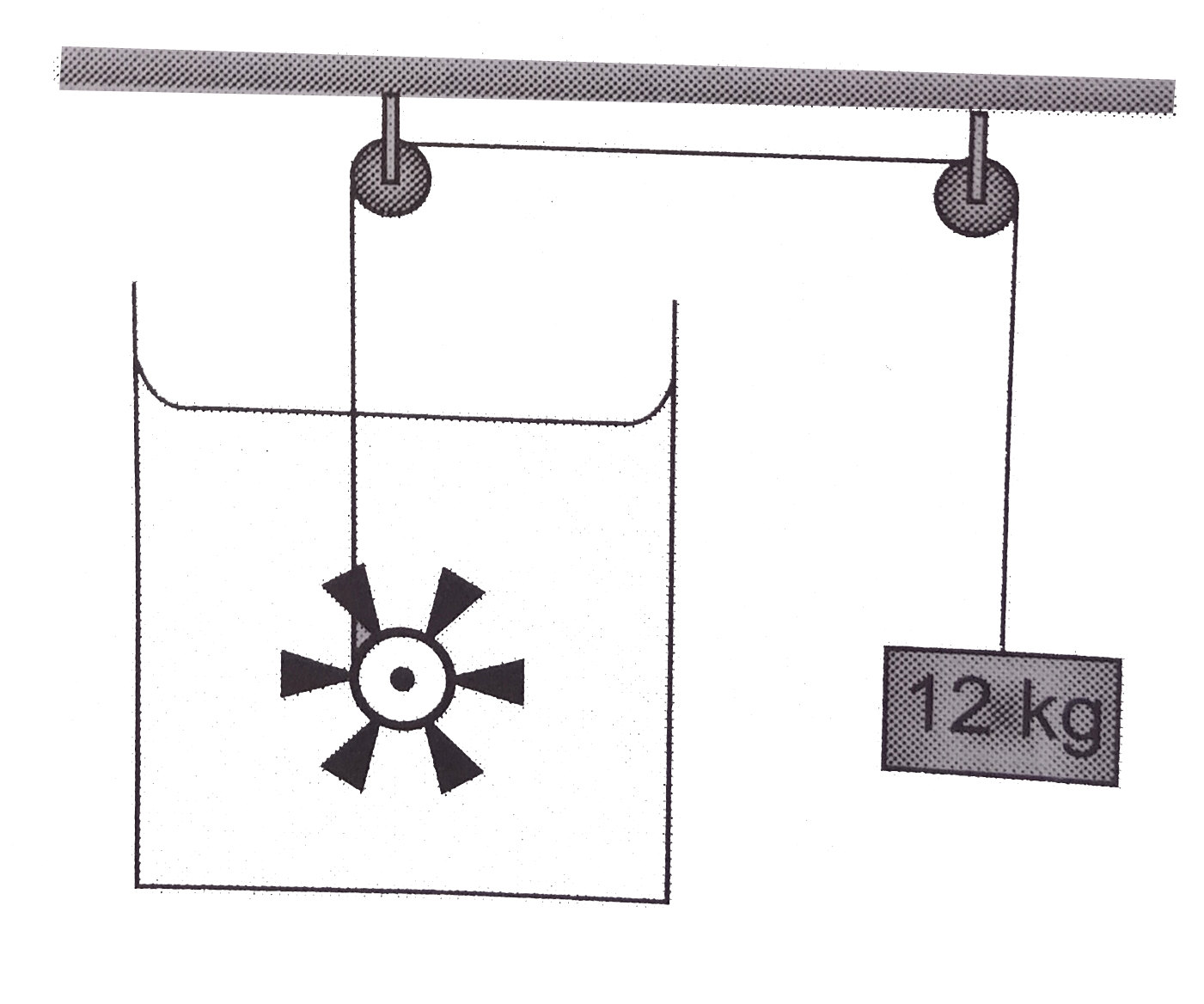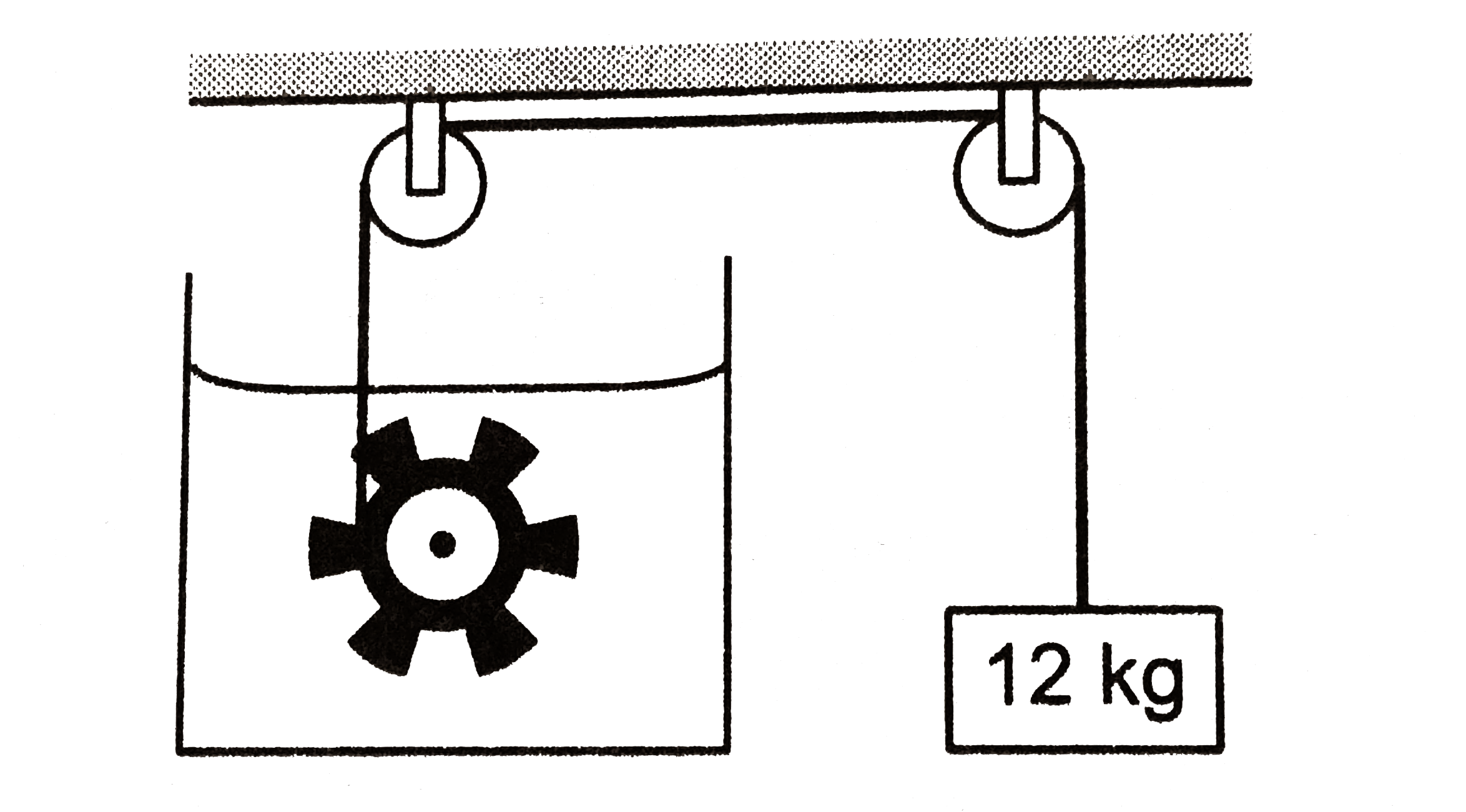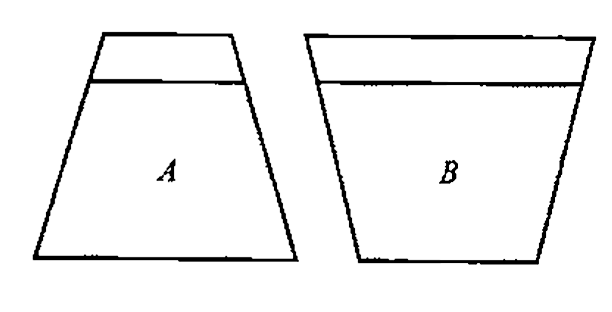A paddle wheel is connected with a block of mass 10kg as shown in figure. The wheel is completely immersed in liquid of heat capacity 400J/K . The container is adiabatic. For the time interval in which block goes down 1m slowly calculate
(a) Work done on the liuid
(b) Heat supplied to the liquid
(c ) Rise in the temperature of the liquid Neglect the heat capacity of the container and the paddle. (g=10m/s2)

The correct Answer is:(a) 100J (b) 0 (c ) 1/40.∘C
Step by step video, text & image solution for A paddle wheel is connected with a block of mass 10kg as shown in figure. The wheel is completely immersed in liquid of heat capacity 400 J//K . The container is adiabatic. For the time interval in which block goes down 1m slowly calculate (a) Work done on the liuid (b) Heat supplied to the liquid (c ) Rise in the temperature of the liquid Neglect the heat capacity of the container and the paddle. (g = 10 m//s^(2)) by Physics experts to help you in doubts & scoring excellent marks in Class 11 exams.
Updated on:21/07/2023Topper's Solved these Questions
- CALORIMETRY AND THERMAL EXPANSIONBOOK - RESONANCECHAPTER - CALORIMETRY AND THERMAL EXPANSIONEXERCISE - Exercise-2
1 Videos
- CALORIMETRY AND THERMAL EXPANSIONBOOK - RESONANCECHAPTER - CALORIMETRY AND THERMAL EXPANSIONEXERCISE - Exercie-3
1 Videos
- CALORIMETRY AND THERMAL EXPANSIONBOOK - RESONANCECHAPTER - CALORIMETRY AND THERMAL EXPANSIONEXERCISE - Exercise-1
1 Videos
- CALORIMETRYBOOK - RESONANCECHAPTER - CALORIMETRYEXERCISE - Exercise
19 Videos
- CAPACITORBOOK - RESONANCECHAPTER - CAPACITOREXERCISE - Exercise
45 Videos
Similar Questions

As shown in figure a paddle wheel coupled to a mass of 12 kg through fixed frictionless pulleys. The paddle is immersed in a liquid of heat capacity 4200JK kept in an adiabatic container. Consider a time interval in which the 12 kg block falls slowly through 70 cm.
(a) How much heat is given to the liquid?
(b) How much work is done on the liquid?
(c ) Calculate the rise in the temperature of the liquid neglecting the heat capacity of the container and the paddle.
View SolutionShows a peddle wheel couple to a mass of 12 kg through fixed frictionless pulleus. The paddle is immersed in a liquid of heat capacity 4200JK−1 kept in an adiabatic container. Consider a time interval in which the 12 kg block falls slowly through 70cm. (a) how much heat is given to the liquid ? (b) how much work is done on the liquid? (c ) calculate the rise in the temperature of the liquid neglecting the heat capacity of the container and the paddle.

View Solution
Knowledge Check
The fundamental frequency of a sonometer wire carrying a block of mass 1 kg and density 1.8 is 260. When the block is completely immersed in a liquid of density 1.2 then what will be its new frequency ?
A300 HzB150 HzC450 HzDNone of theseThe fundamental frequency of a sonometer wire carrying a block of mass 1 kg and density 1.8 is 260. When the block is completely immersed in a liquid of density 1.2 then what will be its new frequency ?
A300 HzB150 HzC450 HzDNone of theseA block of ice at −20∘C having a mass of 2kg is added to a 3kg water at 15∘C. Neglecting heat losses and the heat capacity of the container
AThe final temperature will be less than 0∘CBIce will completely meltCWater will partially freezeDFinal temperature will be more than 0∘C
A lead block of mass 2 kg is supplied with a heat energy of 3600 J. Calculate the rise in temperature, if the sp. heat capacity of lead is 130Jkg−1C−1 .
View SolutionIn a closed container a liquid is stirred with a paddle to increase the temperature. Which of the following is true?
View SolutionA block of mass 5 kg and volume 0.05m3 floats in a liquid of density 140kg m−3 .
The fraction of block inside liquid is
View SolutionTwo vessels A and B of cross sections as shown contain a liquid up to the same height. As the temperature rises, the liquid pressure at the bottom (neglecting expansion of the vessels ) will :

View SolutionA liquid of mass m and specific heat c is heated to a temperature 2T. Another liquid of mass m/2 and specific heat 2 c is heated to a temperature T. If these two liquids are mixed, the resulting temperature of the mixture is
View Solution
